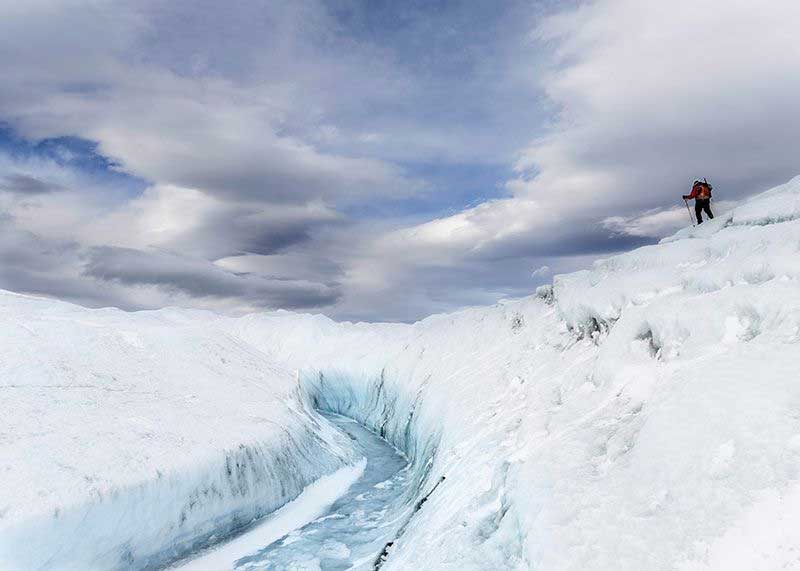
A small airplane from the US Space Science Institute (NASA) can be seen flying about 500 feet below the iceberg. In the blue-green sea, these pieces of white snow look like small dots, but these piles are about the same size as warships or some as tall as 15 stories.
Like other glaciers in Greenland, the large Kangerlussuk area is melting at a rapid rate. In fact, this huge snow mountain is the highest melting point so far this year. NASA scientist Jose Willis has been closely monitoring snowfall events this year. His focus is primarily on finding out the secret of how Greenland's snow is ending with global temperature rise.
Specifically, he aims to find out who plays the role of hot air or hot seawater in melting snow. The answer will greatly help to know the future of the earth.
Generally, the flow of water brings freshness more quickly than air. If the water proves more harmful, "Greenland's snow will melt faster than expected," says Willis. This means that the surface of the sea rises steeply and those living in the coastal areas are more likely to drown.
Greenland's snow melts all the way up to 20 feet above sea level. According to one estimate, about 13 billion 70 million tonnes of snow melted on the same day this month.
"It's terrific," said Willis, pointing to an area covered by more water than snow. "This confirms that the letters of the snow are missing before us."
Climate change is swallowing Greenland's iceberg in two ways. Needless to say, the most important thing is the hot air flowing over Greenland. This year's summer breeze was very harsh. In July, the hot air in Europe served as a "hair dryer" over the greenland sky. The other is the warm, salty water of the sea. This warm North American Gulf Stream warms the coastline of Greenland, and is cutting down the glacier from below.
Tom Mott, a snow scientist at the University of Georgia, who studied the Glacier in Greenland in the early 1990s, did not think most researchers thought the glacier would be affected by the oceanic flow. Tom Mott is not currently involved in the research team.
The project by Willis, named by the sea is melting Greenland (OMG), has shown that water is actually responsible for melting Greenland. The question is, how much and how soon?
Willis's team is measuring temperatures about 660 feet below sea level. In the preliminary description, this waterfall is very warm and salty. This inward water flow is doing great damage.
NASA has been spending five years measuring the interior of the waterfront. The project uses a 77-year-old DC-3 aircraft built for World War II. Willis, project manager Ian McQueen and mechanic Rich Gill drop exploration equipment, such as cylinders, into the waterfront by plane. These devices reach the inner surface by releasing cold water, and the interior is studied by sensors connected to the aircraft.
Cacubin records the temperature and saltiness of the ocean's inland seawater on their computer.
A cylinder device costs about US $ 2,000. During the last year or two, when studying the Kangerlussuk in the eastern part of Greenland, there was not much change in the inland seawater. This can be really good news. But this is the only study point.
NASA has been studying everywhere in Greenland every year for the past four years. But the details received do not look as encouraging.
If scientists conclude that oceanic water plays a greater role, the sea level is sure to rise faster than expected. Because 90 percent of the heat generated by climate change is dissolved in the ocean, Willis said. Warm water has more effect than air, and if touched by melting snow, the effect is immediate.
Generally, seawater is much slower than air, but warm water takes longer to cool down. Water weakens the glacier and helps to break the icebergs. These snow piles eventually melt into the sea.
"Some of the snowstorms are just like any other city," Willis said.
In 2019, Danish climate scientist Ruth Mottram studied 28 glaciers in Greenland. In his study, almost all of these glaciers were seen melting. Only one or two were shown to be stable.
"Not a single glacier has a problem, it is only natural to make everyone concerned when all 28 of them have problems," Motram told the AP.
In 2017, coastal glaciers and snow climatic studies also showed that much snow melted in 1997. Since then the snowmelt has continued at a very rapid rate, and similar studies by Willis have indicated. NASA's satellite image also showed that about 255 billion metric tons of snow melted each year from 2003 to 2016, and the melting rate was horrible.
Still, it will take hundreds of years for all of Greenland's snow to melt, but the key question is how quickly it will melt. By the end of the year 2100, only the snow in Greenland will rise to 3 or 4 feet above sea level, said Willis, adding that warm water played a greater role than scientists anticipated.
Other scientists, such as Ted Scambos of the University of Colorado, say that because of Greenland, the surface of the sea will only increase by 1 foot by 2100. Nevertheless, it will greatly damage the area.





